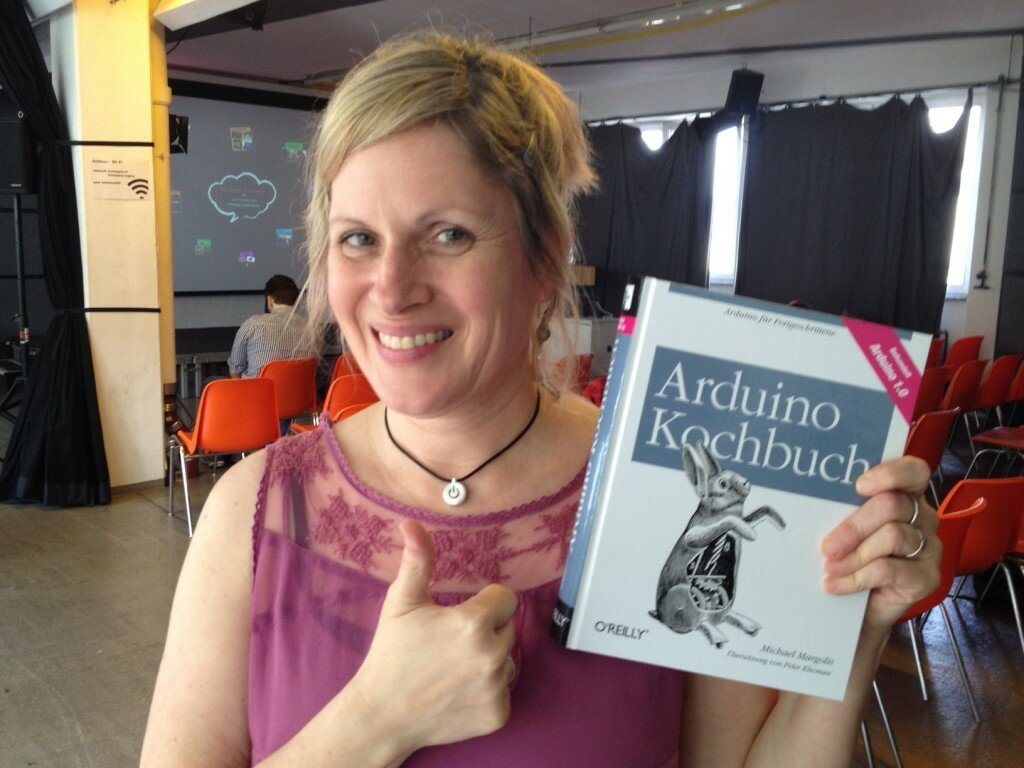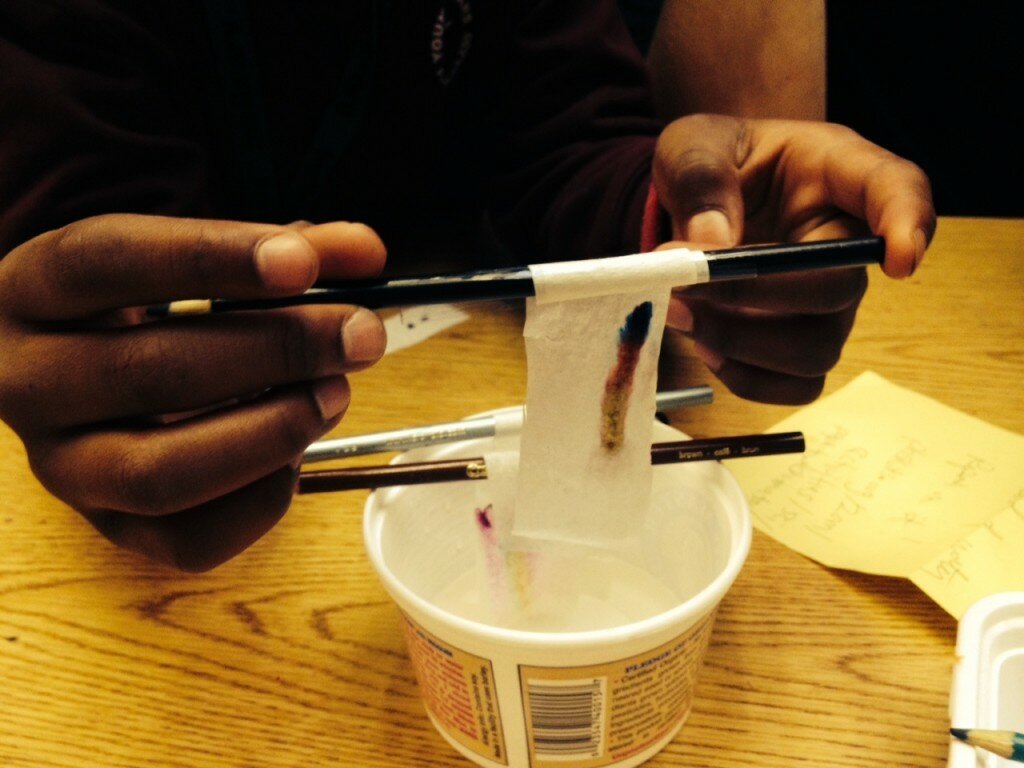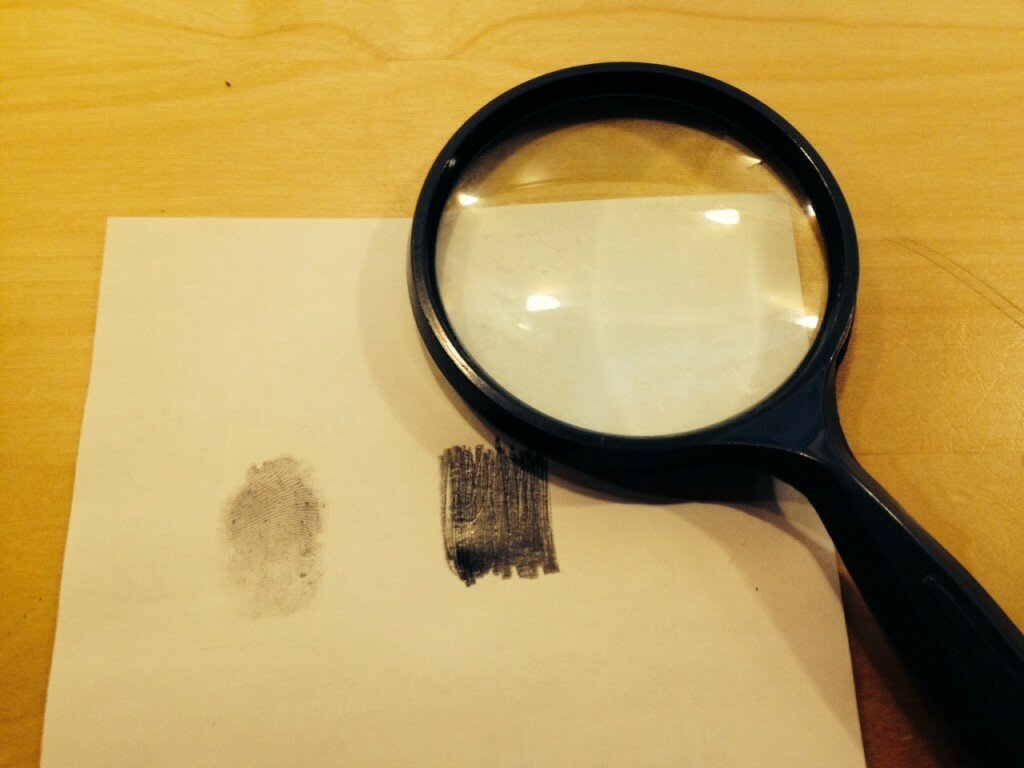This is me at a conference holding something I’m comfortable with–an Arduino Cookbook. Of course I’m usually looking at the English version, but anyone that knows me will tell you that I love microcontrollers and making things blink. Anyway, as I prepared for a recent visit to the Cecil B. Moore library, I realized I was tired of doing things I was comfortable with, like circuits and solder. It’s great for the kids to learn these skills, but I wasn’t really putting myself in their shoes and being in a place of not knowing. So, I decided to venture out of my comfort zone and look more closely at something that I’m not as cozy with–science. What I found was some fun activities that I actually wanted to try!
The first was sort of a detective game concerning pens. What if you were at a murder scene and you found a note. What if you could determine which pen at the scene was used to write the note? Pretty cool, right? Welcome to the science of Chromatography. This is the ability to separate individual components in a mixture. You may have had this in chemistry class, using it to identify different pigments in leaves. In this case, we are able to use the same science to distinguish different inks. It’s really simple and here’s a link for the process. Basically you just take filter paper (or an on-hand paper towel) and place a streak of the magic marker you want to test. You suspend it on a pencil and dip it into a cup of water without having the water line touch the ink. Eventually the water will be absorbed and the true colors of the ink will be shown. The kids really enjoyed this process and had no problem waiting for and watching the results. It works best with black water based markers, but you can experiment with other colors, too. The interesting part was that permanent markers wouldn’t work, because you need alcohol or nail polish remover as the solvent. It was a fun learning experience and I knew it was a success when one of the students called their mom and said, “I’m going to be late because I’m helping with an experiment”. Advantages of this experiment is that it is easy to do, interesting and very cost effective. You probably have all the materials you need at your location already.
I decided the detective theme was going well, so I decided to embark on something my CSI inspired niece had been excited about–fingerprints. One day she looked at my fingertips and started identifying the different characteristics of the ridges. I remember being taught that fingerprints were one of a kind, but apparently that isn’t exactly the case. So, armed with a fingerprint guide, I went back to the library and got all my kids scribbling. Once they had all squashed their finger on a scribble of carbon, I had them apply clear tape on their tip. Then, they put the tape down on their paper and got to work with the sleuthing fun. I brought along my mega magnifying glass that I use for reading microcontrollers, and the kids took turns interpreting their results. What we learned is that people can share certain characteristics in their prints, but their complete finger combination will be different. My smudgy thumb print above appeared to be a loop, and I recall that my other fingers were different, so it’s fun to examine them all. FYI about 60% of people have loops, 35% have whorls and 5% have arches. At the end of afternoon, I had kids pair up and share their “dactylogram” results. I should mention that the students at this library are generally quite physical, but during this exercise they were really calm and getting along well. Considering we are in the melting pot of Philadelphia, it was fun to share our similarities and differences in this way.
Speaking of differences, with the current issues of racism plaguing our country, anything dealing with police or forensics can be touchy, yet it can also be an opening for communication. Just use caution. Also, just a note that I looked at several finger print guides before choosing the one listed above. Be watchful of stereotypes in photos as you look at anything dealing with detective activities.
Well, that’s the start of my STEAM journey stretching from my art/tech background and onto the beyond. I hope I’ve encouraged you to google activities different from your norm where you don’t know what the result will be. Personally, I think it’s more fun when you don’t know the answer and it’s fun to share that honesty with the students. My next challenge is going to be math, something that was always a sore spot in my life LOL. I’m already looking at tessellation art for the cubist in me. Hellooo, geometry. Hack on!




We did this activity at Widener and tested out some different kinds of “filter paper”. Out of all the stuff we experimented with, unbleached Melitta brand coffee filters worked the best (https://www.freshdirect.com/media/images/product/grocery_27/gro_melitta_filter2brown_z.jpg). You could really see each marker dot separating into different pigments on that paper. Something that didn’t work at all was regular white drip machine coffee filters, so don’t waste your time with those!